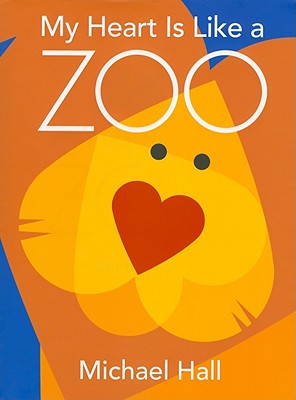My Heart Is Like a Zoo
http://www.myheartislikeazoo.com/
By Michael Hall
Publication Date: January 2010
Other Editions of This Title: (January 2010)
Categories: Animals , Emotions & Feelings
 |
Selected by Indie Booksellers for the Spring 2010 Kids' Next List
“Feelings are characterized by animals created entirely of hearts in this energetic picture book. My Heart is Like a Zoo is a refreshing Valentine's Day choice and a must-have for school libraries.”
-- Camille DeBoer, Pooh's Corner, Grand Rapids, MI
Description
A heart can be hopeful, or silly, or happy. A heart can be rugged, or snappy, or lonely. A heart holds every different feeling, and debut author-artist Michael Hall captures each one with a delicate touch.
For each feeling, the bold, graphic artwork creates an animal out of heart shapes, from "eager as a beaver" to "angry as a bear" to "thoughtful as an owl." An accessible and beautiful debut, My Heart Is Like a Zoo is everything a classic picture book should be: honest, sincere, and speaking directly to even the very youngest child.
Ages: 0 - 5
For each feeling, the bold, graphic artwork creates an animal out of heart shapes, from "eager as a beaver" to "angry as a bear" to "thoughtful as an owl." An accessible and beautiful debut, My Heart Is Like a Zoo is everything a classic picture book should be: honest, sincere, and speaking directly to even the very youngest child.
Ages: 0 - 5
About the Author
Michael Hall is the creator of the critically acclaimed and nationally best-selling picture book My Heart Is Like a Zoo. He is also an award-winning graphic designer whose work has been widely recognized for its simple and engaging approach. Michael Hall is the co-owner and principal designer at Hall Kelley, Inc., and lives with his wife and two daughters in Minnesota.
Praise For My Heart Is Like a Zoo…
“Children just learning about shapes will revel in these pages.”
-Publishers Weekly
“The bold digital collages of zoo animals in this debut picture book are clear and bright, and the simple rhymes about feelings will have preschoolers savoring the words, joining in, and pointing at every playful zoo scene.”
-ALA Booklist
“Starting with one simple shape, Michael Hall shows us a nearly infinite number of ways to make a menagerie of love.”
-Brian Selznick, Caldecott Medalist
“This title will have a wide audience, whether in a classroom, library, or at home. An outstanding choice for one-on-one sharing.”
-School Library Journal
“Now hear this! The art in this book will astonish Earth!”
-Chris Raschka, Caldecott Medalist
“It stole my heart.”
-Robert Sabuda, New York Times bestselling author
“Animals, adjectives and hearts—lots of hearts—combine in this bright, appealing selection, reminiscent of the works of Lois Ehlert.”
-Kirkus Reviews
“Michael Hall’s My Heart Is Like a Zoo is a combination of deceptive simplicity and gorgeous graphic design. Colorful, fun, and thoroughly enjoyable.”
-Laura Vaccaro Seeger, Caldecott Honor Artist, New York Times bestselling author






